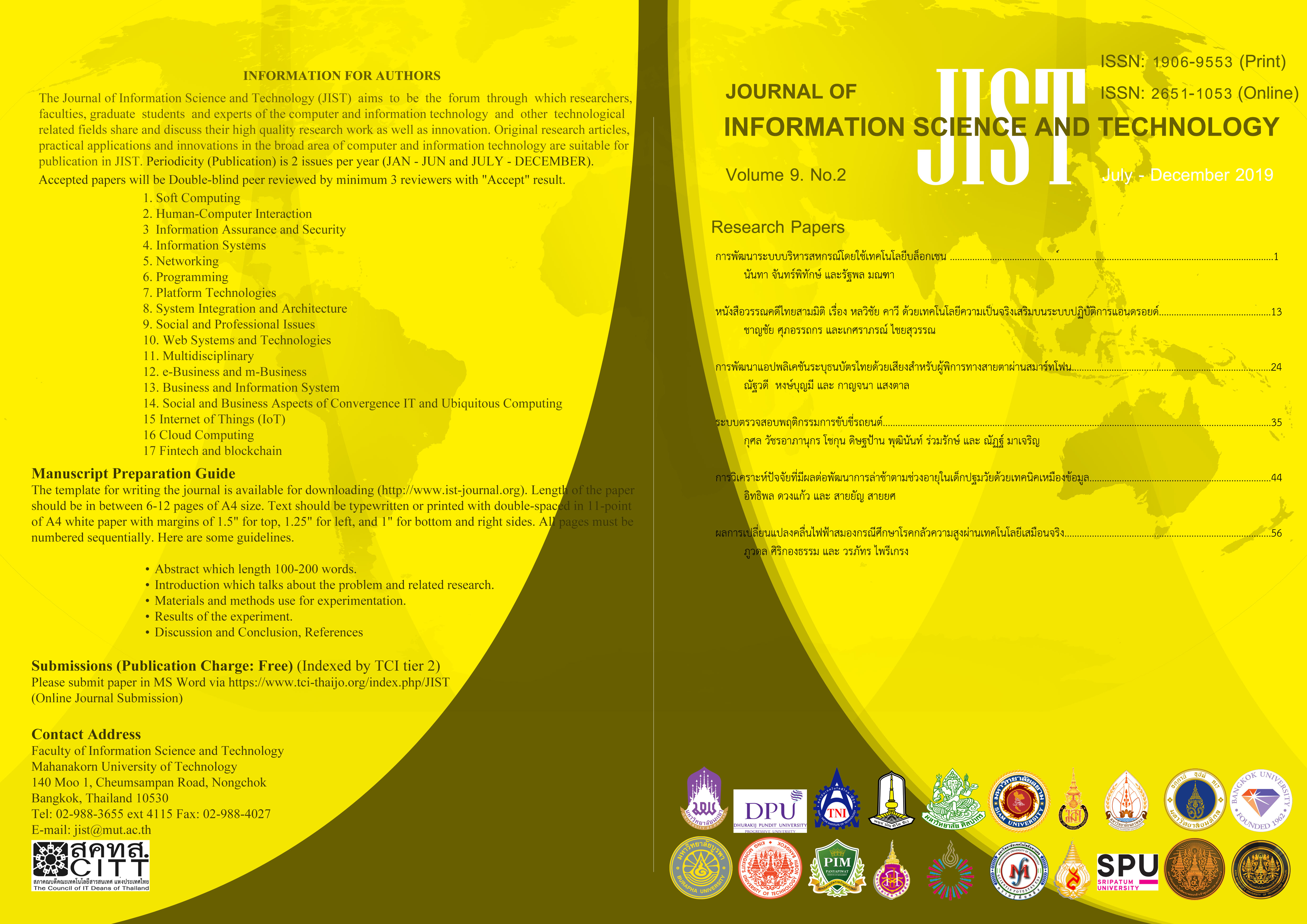Three-dimensional Thai Literature Book: Holwichai and Kawee with Augmented Reality Technology on Android Operating System
Main Article Content
Abstract
The purpose of this research were to 1) Design and development of a three-dimensional Thai literature book: Holwichai and Kawee with augmented reality technology on android operating system. 2) Satisfaction study with three-dimensional Thai literature book: Holwichai and Kawee. Story was simulated in animation. The results showed that 1) There are 6 steps in design and development process, consisting of 13 scenes of story in three-dimensional. 2) The satisfaction study of 50 users showed the average of users’ satisfaction was in strongly agree level (= 4.64) and standard deviations (S.D.) at 0.58. It was found that the three-dimensional Thai literature book: Holwichai and Kawee for enhancement of understanding, increased motivation to learn, and cultural preservation.
Article Details
This work is licensed under a Creative Commons Attribution-NonCommercial-NoDerivatives 4.0 International License.
I/we certify that I/we have participated sufficiently in the intellectual content, conception and design of this work or the analysis and interpretation of the data (when applicable), as well as the writing of the manuscript, to take public responsibility for it and have agreed to have my/our name listed as a contributor. I/we believe the manuscript represents valid work. Neither this manuscript nor one with substantially similar content under my/our authorship has been published or is being considered for publication elsewhere, except as described in the covering letter. I/we certify that all the data collected during the study is presented in this manuscript and no data from the study has been or will be published separately. I/we attest that, if requested by the editors, I/we will provide the data/information or will cooperate fully in obtaining and providing the data/information on which the manuscript is based, for examination by the editors or their assignees. Financial interests, direct or indirect, that exist or may be perceived to exist for individual contributors in connection with the content of this paper have been disclosed in the cover letter. Sources of outside support of the project are named in the cover letter.
I/We hereby transfer(s), assign(s), or otherwise convey(s) all copyright ownership, including any and all rights incidental thereto, exclusively to the Journal, in the event that such work is published by the Journal. The Journal shall own the work, including 1) copyright; 2) the right to grant permission to republish the article in whole or in part, with or without fee; 3) the right to produce preprints or reprints and translate into languages other than English for sale or free distribution; and 4) the right to republish the work in a collection of articles in any other mechanical or electronic format.
We give the rights to the corresponding author to make necessary changes as per the request of the journal, do the rest of the correspondence on our behalf and he/she will act as the guarantor for the manuscript on our behalf.
All persons who have made substantial contributions to the work reported in the manuscript, but who are not contributors, are named in the Acknowledgment and have given me/us their written permission to be named. If I/we do not include an Acknowledgment that means I/we have not received substantial contributions from non-contributors and no contributor has been omitted.
References
2. แม้นมาส ชวลิต. “งานเขียนเก่าๆ ของไทยไฉนเด็กวัยรุ่นทำเมิน” บริษัทอักษรโสภณ สกุลไทย. กรุงเทพฯ, 2537
3. สมถวิล วิเศษสมบัติ. “วิธีสอนภาษาไทยระดับมัธยมศึกษา” บริษัทอักษรบัณฑิต. กรุงเทพฯ, 2528
4. Ding-Yu L, “Combined with augmented reality navigation application in the library”, Proceedings of the IEEE International Conference on Advanced Materials for Science and Engineering, 12-13 November 2016. pp.441- 443.
5. ปิยะฉัตร จารุจินดา ดิศานุวัตร วรจิกาล และธีรพงศ์ ลีลานุ ภาพ, “การประยุกต์ใช้ความเป็นจริงเสริมสำหรับเพิ่ม ประสบการณ์การท่องโลกวรรณคดี”, การประชุมวิชาการระดับประเทศด้านเทคโนโลยีสารสนเทศ ครั้งที่ 8, วันที่ 25-26 ตุลาคม 2559. หน้า 291-296.
6. The Cloud, “สุนทรภู่ never dies”, [เข้าถึงเมื่อ 7 พฤศจิกายน 2562] เข้าถึงได้จาก: https://readthecloud.co/sunthon-phu-museum-wat-thepthidaram/
7. วิกิพีเดีย สารานุกรมเสรี, “คอมพิวเตอร์แอนิเมชัน”, [เข้าถึงเมื่อ 6 ธันวาคม 2562] เข้าถึงได้จาก: https://th.wikipedia.org/wiki/คอมพิวเตอร์แอนิเมชัน
8. Steve Aukstakalnis. “Practical Augmented Reality” Pearson Education. USA, 2016
9. Dieter S. and Tobias H. “Augmented Reality” Pearson Education. USA, 2016
10. Sanni S. “Theory and applications of marker-based augmented reality” Hulkaisija Utgivare. Finland, 2012
11. พงศ์พูน พิบูลย์เกษตรกิจ. “ดุษฎีนิพนธ์การประพันธ์เพลง: หลวิชัย คาวี เดอะมิวสิคัล” ศิลปกรรมศาสตดุษฎีบัณฑิต สาขาวิชาศิลปกรรมศาสตร์. จุฬาลงกรณ์มหาวิทยาลัย, 2560
12. Expert Corporation, “UX Design คืออะไร”, [เข้าถึงเมื่อ 9 ธันวาคม 2562] เข้าถึงได้จาก: https://www.9experttraining.com/articles/ux-design-คืออะไร
13. Demeter ICT, “UX2UI คืออะไร?”, [เข้าถึงเมื่อ 9 ธันวาคม 2562] เข้าถึงได้จาก:https://www.dmit.co.th/th/blog/2019/05/29/ux-vs-ui/
14. ยุพาวดี ฐานขันแก้ว, “การพัฒนาหนังสือภาพเสมือนจริงเรื่อง ไตรภูมิพระร่วง (มหานรก)”, การประชุมวิชาการระดับชาติ มหาวิทยาลัยเทคโนโลยีราชมงคลสุวรรณภูมิ ครั้งที่ 3, วันที่ 27 เมษายน 2561. หน้า 414-422.
15. ภูวภัสสร์ อินอ้าย วิวัฒน์ มีสุวรรณ และพิชญาภา ยวงสร้อย, “การพัฒนาชุดการสอนด้วยเทคโนโลยีออคเมนเต็ดเรียลลิตี เรื่องรามเกียรติ์ ตอนศึกไมยราพ สำหรับนักเรียนมัธยมศึกษาปีที่ 1”, วารสารศึกษาศาสตร์ มหาวิทยาลัยนเรศวร, ปีที่ 19 ฉบับที่ 2 เมษายน - มิถุนายน 2560. หน้า 155-166.



